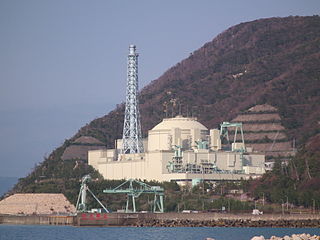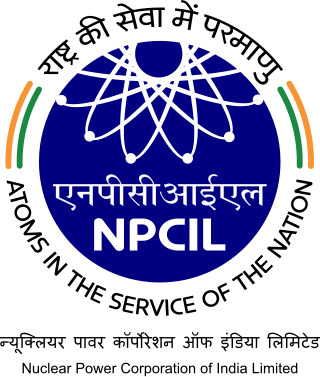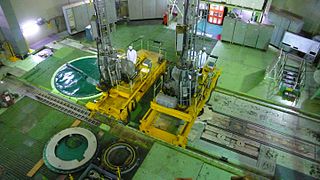
A breeder reactor is a nuclear reactor that generates more fissile material than it consumes. These reactors can be fueled with more-commonly available isotopes of uranium and thorium, such as uranium-238 and thorium-232, as opposed to the rare uranium-235 which is used in conventional reactors. These materials are called fertile materials since they can be bred into fuel by these breeder reactors.

Monju (もんじゅ) was a Japanese sodium-cooled fast reactor, located near the Tsuruga Nuclear Power Plant, Fukui Prefecture. Its name is a reference to Manjusri. Construction started in 1986 and the reactor achieved criticality for the first time in April 1994. The reactor has been inoperative for most of the time since it was originally built. It was last operated in 2010 and is now closed.

Dounreay is a small settlement and the site of two large nuclear establishments on the north coast of Caithness in the Highland area of Scotland. It is on the A836 road nine miles west of Thurso.

The Bhabha Atomic Research Centre (BARC) is India's premier nuclear research facility, headquartered in Trombay, Mumbai, Maharashtra, India. It was founded by Homi Jehangir Bhabha as the Atomic Energy Establishment, Trombay (AEET) in January 1954 as a multidisciplinary research program essential for India's nuclear program. It operates under the Department of Atomic Energy (DAE), which is directly overseen by the Prime Minister of India.

The Nuclear Power Corporation of India Limited (NPCIL) is an Indian public sector undertaking based in Mumbai, Maharashtra. It is wholly owned by the Government of India and is responsible for the generation of electricity from nuclear power. NPCIL is administered by the Department of Atomic Energy (DAE).

Indira Gandhi Centre for Atomic Research (IGCAR) is one of India's premier nuclear research centres. It is the second largest establishment of the Department of Atomic Energy (DAE), next to Bhabha Atomic Research Centre (BARC), located at Kalpakkam, 80 km south of Chennai, India. It was established in 1971 as an exclusive centre dedicated to the pursuit of fast reactor science and technology, due to the vision of Vikram Sarabhai. Originally, it was called Reactor Research Centre (RRC). It was renamed to Indira Gandhi Centre for Atomic Research (IGCAR) by the then Prime Minister of India Rajiv Gandhi in December 1985. The centre is engaged in broad-based multidisciplinary programme of scientific research and advanced engineering directed towards the development of fast breeder reactor technology in India.

Madras Atomic Power Station (MAPS) located at Kalpakkam about 80 kilometres (50 mi) south of Chennai, India, is a comprehensive nuclear power production, fuel reprocessing, and waste treatment facility that includes plutonium fuel fabrication for fast breeder reactors (FBRs). It is also India's first fully indigenously constructed nuclear power station, with two units each generating 220 MW of electricity. The first and second units of the station went critical in 1983 and 1985, respectively. The station has reactors housed in a reactor building with double shell containment improving protection also in the case of a loss-of-coolant accident. An Interim Storage Facility (ISF) is also located in Kalpakkam.
The advanced heavy-water reactor (AHWR) or AHWR-300 is the latest Indian design for a next-generation nuclear reactor that burns thorium in its fuel core. It is slated to form the third stage in India's three-stage fuel-cycle plan. This phase of the fuel cycle plan was supposed to be built starting with a 300 MWe prototype in 2016.

The Fast Breeder Test Reactor (FBTR) is a breeder reactor located at Kalpakkam, Tamil Nadu, India. The Indira Gandhi Center for Atomic Research (IGCAR) and Bhabha Atomic Research Centre (BARC) jointly designed, constructed, and operate the reactor.

The Department of Atomic Energy (DAE) is an Indian government department with headquarters in Mumbai, Maharashtra, India. DAE was established in 1954 with Jawaharlal Nehru as its first minister and Homi Bhabha as its secretary.
The Prototype Fast Breeder Reactor (PFBR) is a 500 MWe fast breeder nuclear reactor presently being constructed at Kokkilamedu, near Kalpakkam, in Tamil Nadu state, India. The Indira Gandhi Centre for Atomic Research (IGCAR) is responsible for the design of this reactor. The facility builds on the decades of experience gained from operating the lower power Fast Breeder Test Reactor (FBTR). At first, the reactor's construction was supposed to be completed in September 2010, but there were several delays. The Prototype Fast Breeder Reactor is scheduled to be put into service in December 2024, which is more than 20 years after construction began and 14 years after the original commissioning date, as of December 2023. The project's cost has doubled from ₹3,500 crore to ₹7,700 crore due to the multiple delays.
Nuclear power is the fifth-largest source of electricity in India after coal, gas, hydroelectricity and wind power. As of November 2020, India has 22 nuclear reactors in operation in 8 nuclear power plants, with a total installed capacity of 7,380 MW. Nuclear power produced a total of 43 TWh in 2020–21, contributing 3.11% of total power generation in India. 10 more reactors are under construction with a combined generation capacity of 8,000 MW.

India's three-stage nuclear power programme was formulated by Homi Bhabha, the well-known physicist, in the 1950s to secure the country's long term energy independence, through the use of uranium and thorium reserves found in the monazite sands of coastal regions of South India. The ultimate focus of the programme is on enabling the thorium reserves of India to be utilised in meeting the country's energy requirements. Thorium is particularly attractive for India, as India has only around 1–2% of the global uranium reserves, but one of the largest shares of global thorium reserves at about 25% of the world's known thorium reserves. However, thorium is more difficult to use than uranium as a fuel because it requires breeding, and global uranium prices remain low enough that breeding is not cost effective.
Shivram Baburao Bhoje is a distinguished Indian nuclear scientist who worked in the field of fast-breeder nuclear reactor technology for forty years in the design, construction, operation, and research and development. Indian government has honoured him with Padma Shri in 2003, the fourth highest civilian award in India, for his distinguished service to science and engineering fields.

The China Experimental Fast Reactor (CEFR) is China's first fast nuclear reactor, and is located outside Beijing at the China Institute of Atomic Energy. It aims to provide China with fast-reactor design, construction, and operational experience, and will be a key facility for testing and researching components and materials to be used in subsequent fast reactors. The reactor achieved first criticality on July 21, 2010 and started generating power a year later on July 21, 2011. In October 2012 Xinhua announced that the CEFR has passed official checks. The CEFR was brought to full power at 5.00pm on 15 December 2014 and operated at this level continuously for three full days.

The Prime Minister's Office (PMO) consists of the immediate staff of the Prime Minister of India, as well as multiple levels of support staff reporting to the Prime Minister. The PMO is headed by the Principal Secretary, currently Pramod Kumar Mishra. The PMO was originally called the Prime Minister's Secretariat until 1977, when it was renamed during the Morarji Desai ministry.

Ratan Kumar Sinha, is an Indian nuclear scientist and mechanical engineer. He had served as the Secretary to the Government of India, Department of Atomic Energy (DAE) and Chairman of the Atomic Energy Commission (AEC), Government of India from April 2012 to October 2015. Prior to that, Ratan Kumar Sinha had served as Director of Bhabha Atomic Research Centre (BARC), Mumbai from May 2010 to June 2012. During the four decades of his career, Ratan Kumar Sinha held several important positions related to design & development of nuclear reactors for the Indian nuclear programme. He has been actively involved in the development of the advanced heavy water reactor (AHWR) and Compact High Temperature Reactor (CHTR), two of the highly acknowledged technological innovations which are suitable for large scale deployment of nuclear power, particularly in India.

Sekhar Basu was an Indian nuclear scientist who served as the chairman of the Atomic Energy Commission and Secretary to the Government of India, Department of Atomic Energy (DAE). He also served as the Director of Bhabha Atomic Research Centre (BARC), the Project Director of Nuclear Submarine Program, and later as the Chief Executive of the Nuclear Recycle Board at Bhabha Atomic Research Center. He was a recipient of India's fourth highest civilian honor Padma Shri in 2014.
The Fast Breeder Reactor-600 (FBR-600) or Indian Fast Breeder Reactor (IFBR) or Commercial Fast Breeder Reactor (CFBR) is a 600-MWe fast breeder nuclear reactor design presently being designed as part of India's three-stage nuclear power programme to commercialise the Prototype Fast Breeder Reactor built at Kalpakkam. The Indira Gandhi Centre for Atomic Research (IGCAR) is responsible for the design of this reactor as a successor for Prototype Fast Breeder Reactor (PFBR). The 1st twin unit would come up within the BHAVINI premises at Madras Atomic Power Station at Kalpakkam, close to the PFBR site itself.
Chokkanathapuram Venkataraman Sundaram was an Indian chemical metallurgist, best known for the commissioning of the Fast Breeder Test Reactor at Kalpakkam. He was the director of the Indira Gandhi Centre for Atomic Research (IGCAR). He was a recipient of the Sanjay Gandhi Award for Science and Technology as well as the National Metallurgists Day Award and an elected fellow of the Indian National Science Academy, the Indian Academy of Sciences and the Indian National Academy of Engineering. The Government of India awarded him the Padma Bhushan, the third highest civilian award, in 1986.












